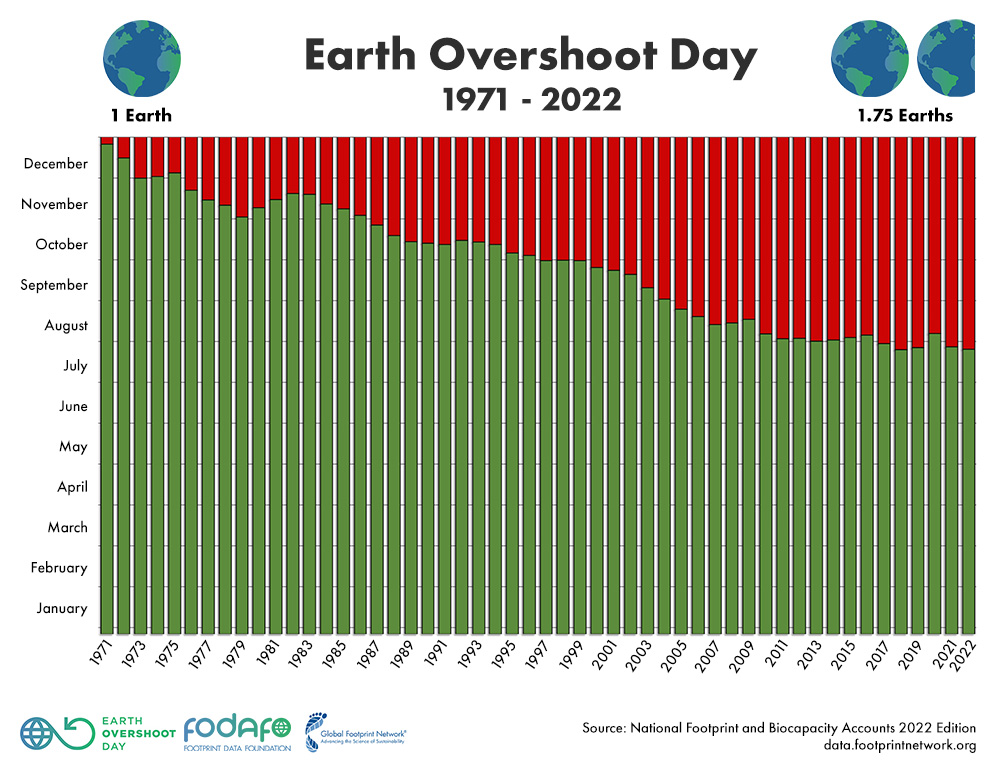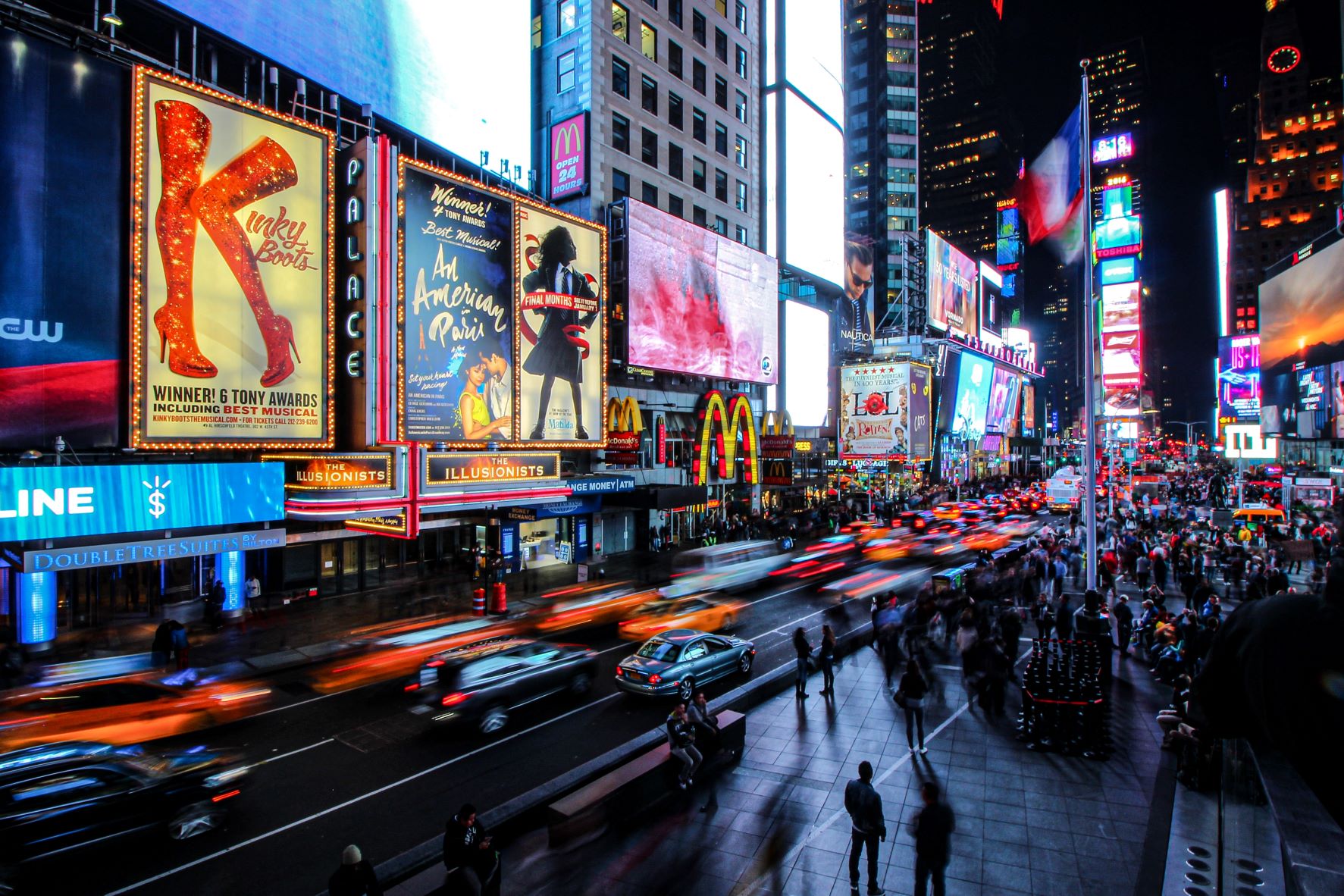Earth Overshoot: How can we achieve true sustainability?
Written by Olivia Nater | Published: July 25, 2022
July 28, 2022, is Earth Overshoot Day, the day on which we’ve exceeded our planet’s resource budget for the entire year. With our planetary overshoot getting progressively worse since Earth Overshoot Day first began more than 50 years ago, we’re running out of time to avert irreversible environmental damage and resource shortages.
What exactly is Earth Overshoot Day?
Earth Overshoot Day was developed by the Global Footprint Network as a warning that humanity is not living within our planet’s ecological boundaries. Overshoot Day is the date on which we’ve used up all the natural resources that the Earth can renew in a year. The first Earth Overshoot Day fell on December 30, 1970. In other words, 1970, when the human population was 3.7 billion—less than half what it is today—was the year when humans started using more than the planet can regenerate in a year.
Due to rapid growth in both population and consumption since the 1970s, Earth Overshoot Day has been arriving earlier every year. This year it’s on July 28, meaning from July 28 to December 31, we’re effectively in ecological deficit. Another way to think of this is in terms of how many Earths we would require to satisfy our current resource demand without using more than our planet can provide. The answer is 1.75 — we would need an additional planet that is three-quarters the size of our current one. But we only have the one and always will.

Moving the date
2020 was an exceptional year because Earth Overshoot Day was actually pushed back to August 22. The reason? The Covid-19 pandemic, which forced the human enterprise to scale back its destructive activities. These activities bounced back with a vengeance as soon as lockdowns were lifted and economies were stimulated, however, so how can we move back Overshoot Day in a planned, non-disastrous and permanent way?
As our impact on the environment is a product of how much we consume and how many of us there are, there are two ways we can reduce humanity’s footprint: decrease consumption and reduce population (voluntarily, of course, through better access to family planning education and services).
The consumption factor
Some environmentalists incorrectly argue that overconsumption is the only problem and that our numbers are irrelevant. Basic math logic means that if we ignore the population factor, to achieve sustainability, we would have to reduce the consumption factor more radically. The Global Footprint Network’s calculations show how many planets we would need if all 7.9 billion of us alive today consumed like the average citizens of specific countries. The U.S. is among the least sustainable — if the entire global population shared the average American lifestyle, we would require five Planet Earths to avoid depleting resources faster than they can regenerate!
There are only 60 countries that fall within the one-Earth limit (meaning they do not have an Overshoot Day), and all of them are developing countries — Honduras, Lesotho, Niger, Kyrgyzstan, Sri Lanka, Cambodia, Sudan and the Philippines are among the nations that fall between 0.9 and 1 Earth. If everyone adopted the lifestyle of their average citizens, we would just about manage to live within our planet’s means. Unfortunately, most people aspire to live like the average U.S. citizen, not the average Sri Lankan, so attempts to slash consumption this drastically — while an interesting thought experiment — would be politically unfeasible.

The population factor
Focusing solely on our numbers will not get us out of this mess either. Going back to the U.S. example — if we really did manage to make the “American Dream” a reality for the whole world, this would only be sustainable with a world population one-fifth the size of our current one, approximately 1.6 billion people. Our population was last this small around 1900 — let’s hope we never experience the catastrophic die-offs that would be required to return to this level.
The only true solution
The only way to avoid extreme measures and a dire future is to address both consumption and population. Smarter use of technology can also help lessen the amount by which the other two factors need to be reduced, but it is by no means the silver bullet ‘techno-optimists’ believe it is.
The Global Footprint Network lays out five main solutions: transition to renewable energy, overhaul cities and our food systems (resulting in less driving and meat consumption), protect and restore nature, and aim for a lower population by mid-century.
Their models show that if, on average, every other family had one fewer child than projected under the UN’s medium (most likely) population scenario, and if the average age at which women become mothers was pushed back by two years, we would have a population of 7.7 billion in 2050 — two billion fewer than what the UN estimates. This alone would result in Overshoot Day falling 49 days later, making it the second most powerful of their proposed solutions, after decarbonizing our economies.
Obviously, 49 days is not enough to get us to the end of the year — we also have to implement all the other solutions. We need a profound transformation of our economic systems, including policies that prioritize human and environmental health over profit and that incentivize widespread behavior change.
A sustainable world
 The world’s poorest have a right to consume more, and in wealthy nations, we have a duty to tighten our belts. This doesn’t have to translate into a reduced quality of life. Picture replacing personal vehicles with free public transportation, meat-heavy diets with healthy plant-based ones, strip malls with public green spaces. Instead of rushing through crowded airports for your next vacation, you may be reading a book on a comfortable passenger train. Homes would be smaller but this would result in lower energy bills and more space for nature. The air would be much cleaner thanks to reduced traffic, and stress levels would be lower, meaning people would live longer, healthier lives.
The world’s poorest have a right to consume more, and in wealthy nations, we have a duty to tighten our belts. This doesn’t have to translate into a reduced quality of life. Picture replacing personal vehicles with free public transportation, meat-heavy diets with healthy plant-based ones, strip malls with public green spaces. Instead of rushing through crowded airports for your next vacation, you may be reading a book on a comfortable passenger train. Homes would be smaller but this would result in lower energy bills and more space for nature. The air would be much cleaner thanks to reduced traffic, and stress levels would be lower, meaning people would live longer, healthier lives.
We can end overshoot and achieve a happier, healthier planet. The changes we must make are huge, but the sooner we act, the less difficult the transition will be. We can start by taking action to stabilize our population as soon as possible, as this can be achieved through means that are essential in their own right and that benefit everyone, everywhere — removing all barriers to reproductive health and rights and ensuring women and girls are no longer left behind.

